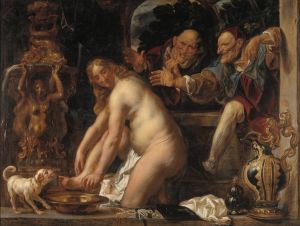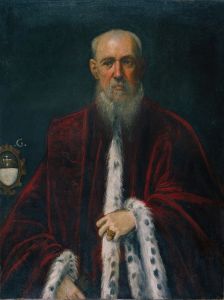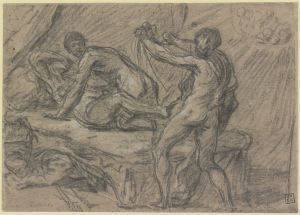
Christ and the Adulteress
A hand-painted replica of Jacopo Tintoretto’s masterpiece Christ and the Adulteress, meticulously crafted by professional artists to capture the true essence of the original. Each piece is created with museum-quality canvas and rare mineral pigments, carefully painted by experienced artists with delicate brushstrokes and rich, layered colors to perfectly recreate the texture of the original artwork. Unlike machine-printed reproductions, this hand-painted version brings the painting to life, infused with the artist’s emotions and skill in every stroke. Whether for personal collection or home decoration, it instantly elevates the artistic atmosphere of any space.
"Christ and the Adulteress" is a painting by the renowned Italian Renaissance artist Jacopo Tintoretto. Tintoretto, whose real name was Jacopo Robusti, was an influential figure in the Venetian school of painting during the 16th century. Known for his dynamic compositions and dramatic use of light and shadow, Tintoretto's works often depicted religious and mythological themes with a distinctive flair.
This particular painting, "Christ and the Adulteress," illustrates a scene from the New Testament, specifically the Gospel of John, chapter 8, verses 1-11. The narrative recounts the story of a woman caught in adultery who is brought before Jesus by the scribes and Pharisees. They intend to test Jesus, asking whether she should be stoned as per Mosaic Law. In response, Jesus famously states, "He that is without sin among you, let him first cast a stone at her." This statement causes the accusers to depart one by one, leaving Jesus alone with the woman. He then tells her, "Neither do I condemn thee: go, and sin no more."
Tintoretto's depiction of this scene is characteristic of his style, capturing the tension and drama of the moment. The composition likely features a strong contrast between light and shadow, a technique known as chiaroscuro, which Tintoretto used to enhance the emotional intensity of his works. This method not only highlights the central figures but also creates a sense of depth and movement within the painting.
The painting reflects Tintoretto's ability to convey complex human emotions and divine interactions. His portrayal of Christ is typically serene and authoritative, embodying both compassion and wisdom. The adulteress, on the other hand, is often depicted in a state of humility and vulnerability, underscoring the themes of forgiveness and redemption central to the biblical story.
While specific details about the creation and history of "Christ and the Adulteress" are limited, it is consistent with Tintoretto's broader oeuvre, which frequently explored themes of morality, divine justice, and human frailty. Tintoretto's works were highly regarded during his lifetime and continue to be celebrated for their innovative approach to composition and narrative.
The painting is part of Tintoretto's extensive body of work, which includes numerous altarpieces, portraits, and large-scale religious scenes. His contributions to the art world have left a lasting legacy, influencing subsequent generations of artists and solidifying his place as one of the great masters of the Renaissance.
"Christ and the Adulteress" exemplifies Tintoretto's skill in bringing biblical stories to life, inviting viewers to reflect on the moral and spiritual lessons they convey. Through his art, Tintoretto not only depicted historical and religious narratives but also engaged with the viewer on a deeper, more introspective level, encouraging contemplation of the human condition and the possibility of redemption.


















